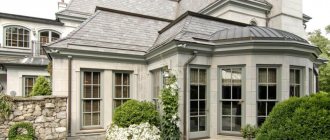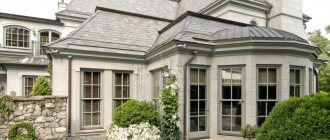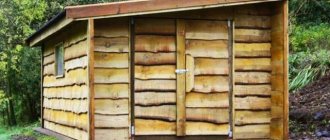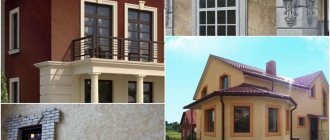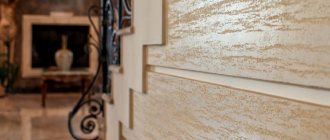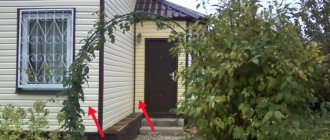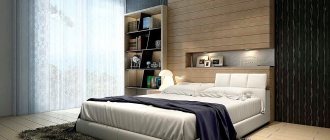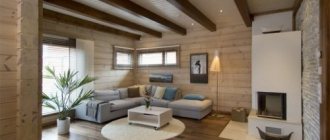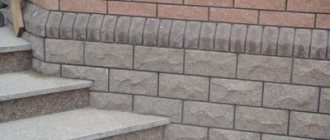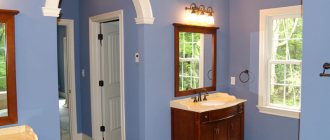Architecture is a science that combines two types of activities: planning and construction of buildings. Architecture, as it was also called in the old days, cannot be mastered without highly specialized knowledge, the baggage of which every talented professional has. The word “architecture” went through a long path of borrowings from other languages before appearing in Russian. At first it was adopted from the Poles, who borrowed the name from Latin, and it migrated to it from Greek, where it meant “chief, main builder.” Architects manage to combine mathematics and art. Their work consists of several stages, the last of which is decoration. If we are talking about monumental buildings, then the common man cannot decorate them.
You can try on the role of an architect only when decorating your own home. Usually, average private dwellings are similar to each other, like standard copies: standard two or three windows on the facade, on one side a veranda with an entrance door. The question is not so much about the owners’ ability to decorate their home beautifully, but rather about simple desire. A design project can be realized even with the help of inexpensive materials. The decor of the facade of the house is no less important than the interior design inside the home. If guests “get acquainted” with the decoration after they are invited, then the exterior will tell any passerby about the special taste of the owners of the site.
The interior is created largely for the convenience of living; architectural solutions are aimed at creating beauty outside. However, do not be mistaken about the complete uselessness of decorative finishing. It becomes an additional support and a strong obstacle to destructive processes that over time begin to affect facades made of any material.
- Decoration materials Foam plastic
- Glass fiber reinforced concrete
- Polyurethane foam
- Polymer concrete
- Decorative columns
- Painting
Design features of facade systems
All types of facade finishing can be divided into two groups:
- thermal insulation – multilayer systems based on insulation, designed to minimize heat loss, increase energy efficiency and decorativeness of the building;
- protective and decorative - multi-layer systems or single-layer materials to protect the building envelope from external factors and increase the attractiveness of the house.
Both thermal insulation and protective and decorative facades come in two types:
- wet - the device technology involves the use of construction and finishing mixtures (masonry mortar, adhesive mixtures, rough plaster, decorative plaster);
- hinged - fixation of system elements is carried out mechanically, in a dry way, using subsystems (lathing, counter-lattice) and hardware (screws, dowels, clamps).
Curtain facades with thermal insulation are always ventilated - air circulation from bottom to top is necessary to maintain the insulation in a dry state. If we are talking about a hinged protective and decorative facade, a ventilation gap is not needed; the cladding is attached either directly to the base or to a subsystem.
Installation technologies
Facade decor for the exterior decoration of houses can be installed in various ways. Currently, the most common among them are:
- Laying decorative elements with special glue. This method is suitable primarily in cases where a small section of the wall is being decorated using individual parts.
- Fastening decorative elements to a frame made of metal guides. This technique is most often used when a curtain wall system is being implemented.
Attaching decorative elements to the frame
The choice of one or another installation technology should be made based on the type of decorative elements used and the surface features of the wall being treated.
Types of facade finishing
Houses of the previous generation could not boast of a wide variety of facades - red brick cladding (ceramics), white brick cladding (silicate), cement-sand plaster coat, paint (panel and wooden houses). Considering that they were built primarily from brick, panels and logs, there was no particular need for other finishing options. With the advent of frame technology and various large-format blocks aimed at mandatory finishing, demand has increased and supply has appeared. The classics have not gone away, both brick and wooden housing construction are at their peak, but several spectacular and effective ways to protect and transform buildings have been added. It is problematic to list all the possible options for decorative finishing of the facade of a house; something original always appears, so let’s look at the most popular ones.
- Siding.
- Facade panels.
- Wood cladding.
- Decorative plaster.
- Brick cladding.
- Tiles on the facade.
- Stone cladding.
Siding
This category unites a large group of materials for facade cladding with common characteristic features:
- long typesetting panels imitating a wooden board or log;
- fixation of type-setting elements with hardware to a wooden, metal or polymer subsystem (curtain façade);
- high decorativeness - the cladding does not require additional manipulations; after assembly, a completed facade is obtained without the need for treatment with protective and decorative compounds.
Modern siding comes in several varieties.
Vinyl
Produced from polyvinyl chloride (PVC) using the extrusion method, previously the material was characterized by low color fastness and fragility. Today's polymers have improved significantly technically; even in dark collections, the color saturation remains for years, and the resistance to mechanical stress is an order of magnitude higher. In addition to regular vinyl siding, manufacturers offer foam siding, which is thicker, stronger and more durable. Both vinyl and foam siding have a number of advantages.
- Presentable – a large selection of textures and colors, a fairly high level of imitation, thanks to the textured surface.
- Durability - the polymer is resistant to temperature, moisture, and is not subject to corrosion.
- Versatility - due to its low weight and installation method, it can be used on almost any type of base, both with and without insulation.
- Ease of installation - assembly of the subsystem and the cladding itself does not require expensive equipment and professional skills; you can do it yourself. Due to the absence of wet processes, facade finishing with siding is carried out almost all year round.
Three times DadForumHouse Member
Vinyl siding, herringbone, blueberry, the facade was made by myself, on a wooden block.
The disadvantages of siding are largely related to its quality - budget cladding can fade, crack in the cold, and can warp and warp due to severe overheating. Not everyone likes the appearance of siding, but this is purely a matter of taste and financial capabilities; the original is always cooler than the imitation, but also more expensive.
Metal
Corrosion-resistant aluminum siding is the prerogative of public buildings; in the private sphere it is used in combined facades, in fragments. As the main cladding, steel siding with a polymer protective and decorative coating is in demand. Metal also imitates natural wood, most often it is a board, beam, block house or log, but only in profile and pattern, and not in texture. The advantages of metal siding include durability with decorativeness, and versatility with ease of installation. Plus, the metal is not afraid of mechanical stress, does not burn or crack in the cold, and even exceeds its vinyl counterparts in terms of service life.
viktor5000FORUMHOUSE Member
I started decorating at the beginning of winter, half of the house is ready. I’m posting photos for variety, otherwise when I was looking for options, there were few samples on the Internet. Metal is absolutely everywhere: the roof, walls, soffits and trim on windows and doors. There is not a single plastic part.
But damage to the protective layer during installation or operation is fraught with the appearance of corrosion, and rust does not paint any façade. During the work, extreme care must be taken so as not to block all the advantages of the material by careless installation.
Fiber cement
It is made from a mixture of cement binder and reinforcing fiber (fiber, mainly cellulose, but other inclusions are possible) by autoclave hardening. The production cycle allows us to obtain a surface that is as close as possible to wood in texture. The installation technology is standard, usually a wooden or metal subsystem; extensions can be either special or homemade. Fiber cement on the facade is combined with natural wood, stone and plaster. The strength, durability and wear resistance of fiber cement boards is higher than that of vinyl, while metal is inferior in reliability, but this type of siding is the most expensive in terms of cost. The relatively large mass (15-18 m²) is not a drawback; any foundation, be it a monolith, masonry or wooden frame, can withstand such weight. Installation of fiber cement cladding is somewhat more complicated, since the boards are only single and cutting is more labor-intensive, but it is also quite possible to carry out all the manipulations on your own.
Ilya1005FORUMHOUSE Member
The house was covered with fiber cement siding; the workers liked the material. For those who are just going to do this: don’t use branded paint for the ends, you can tint acrylic water-dispersed paint in the desired color, it will be a lot cheaper. Self-tapping screws are also excellent in the hypermarket (800 rubles for 500 pcs.) The manufacturing company has self-tapping screws for 3,200 rubles for 500. You can save a little.
Facade panels
Initially produced specifically for the base, they are characterized by increased strength and resistance to all types of influences, from atmospheric to mechanical. If the siding imitates wood, both in shape and appearance, then the panels repeat fragments of brick or stone cladding; there are also collections for a plaster facade, but less often. The surface can be either smooth, like facing ceramic bricks, or textured, like hand-molded bricks and various types of stone. Panels, like siding, are of several types.
- Polymer - apart from the type, they differ from vinyl siding in greater thickness.
- Fiber cement - the only difference is in shape and texture.
DusyaChashkinaFORUMHOUSE participant
The facade is finished with panels - Japanese, fiber cement, metal subsystem, expensive, but beautiful. All that remains is to finish the blind area. I'm happy with the result!
It is worth considering thermal panels separately, since this relatively new material for facade finishing is both insulation and decorative screen. Unlike polymer and fiber cement panels, thermal panels are fixed directly to the base with glue (adhesive foam) and mechanically, without a subsystem. The thermal insulation layer can be polystyrene foam (EPS), extruded polystyrene foam (EPS, XPS) or polyurethane foam (PPU). The front decorative part is usually made of clinker or ceramic tiles, printed concrete or flexible stone (a combination of acrylic polymer and quartz sand or marble chips).
Vyacheslav715FORUMHOUSE Member
A frame house (OSB exterior cladding) was lined with thermal panels made of polystyrene foam (60 mm) with German clinker tiles in 2003. There are no defects in the facade. They haven’t opened it, but there are no signs of damage (odor, mold, etc.) in the house, photo – winter 2022.
What to look for when choosing material for finishing a house?
- Evaluate the building as a whole.
It is important to take into account its design features and functionality. For a country house, one solution will be optimal; for a cottage or winter house in a village for year-round use, another. - Predict maximum load.
The lighter the cladding, the less wear and tear on the house and the load on the foundation. - Consider thermal insulation
- the sheathing does not perform its function, however, whether the house will be warm depends on the tightness and quality of installation. - Study the installation system.
The simpler and more accessible it is, the higher the quality of the cladding will be. - Choose accessories and platbands.
The tightness of the cladding, additional sound insulation and the aesthetic appeal of the building directly depend on them.
Wood cladding
Wooden cladding is classified as siding, which is not entirely correct - siding is an imitation of wood, not a natural finish. The most common are several types of wood cladding.
- Board - both planed and unplaned boards are used, the orientation is predominantly horizontal butt-joint or overlapped (American), but vertical cladding based on Scandinavian motifs is also found.
- Planken - usually made of larch, a perfectly smooth board with hewn edges and edges, is rarely used as the main material due to its high cost, and is mainly combined with other types of facade finishing.
- Lining is the most common interior wooden finish, but it is also widely used on the facade, the difference is in the type of wood (coniferous is desirable for the street) and thickness (15-25 mm). The lining is a dry, profiled board planed on all sides with a tongue-and-groove system, just like siding.
- Imitation of timber - most often made from coniferous wood, like lining, this type of board has a tongue-and-groove system, plus side chamfers cut at an angle of 40˚. It is used for both interior and exterior decoration, the only difference being the thickness of the planks (20-40 mm). After installation, the facade is indistinguishable from the facade of a house assembled from real profiled timber.
- Block house is also an imitation, mainly external, but not of timber, but of logs, the difference from lining and imitation timber is only in the semi-cylindrical profile shape. From afar, the façade of a block house is indistinguishable from a log house; up close, the ideal geometry and uniform size will be noticeable, which is uncharacteristic even for a rounded log, not to mention a hand-cut one.
- Shingles - unlike the bulk of wood trim, this is small-piece cladding in the form of plates, 5-10 mm thick, up to 400 mm long and 150-20 mm wide. The name of the material is due to the manufacturing method - they “tear” the chock, breaking off dies from it.
Regardless of the type, wooden cladding is attached to the sheathing and hardware (nails, clamps, etc.). The most popular is wood cladding of frames and wooden houses after insulation, but the base can be almost anything. The advantages of natural cladding include:
- Environmentally friendly.
- Decorative.
- Easy to install.
- Resistant to temperature changes and mechanical stress.
The main disadvantages are the relatively short service life, high cost and the need for additional protective and decorative treatment. And such treatment must be repeated every few years, the specific interval depends on the type and quality of the chosen product. Covering paints stay on the facade longer than glazing compounds and impregnations, but not everyone wants to hide the original texture.
Zack75FORUMHOUSE Member
Chopped larch shingles of decent quality and geometry, the dies were attached to the sheathing with special nails with a D-shaped head and a nailer. This is what ended up happening. Bast hut!
I think the idea with rounded corners is especially cool. By the way, it’s easier to match the walls this way. Somehow I didn’t quite understand how to make the outer corners of the shingles, otherwise it would have been difficult and less interesting, IMHO.
Decorative plaster
Wet facade, mainly within the framework of composite insulation systems, although decorative plaster can also be applied to a prepared base without a layer of thermal insulation. In SFTK (facade thermal insulation composite system) the “pie” is standard.
- Insulation – expanded polystyrene (PSB), stone wool slabs, mineral wool slabs (high density).
- The reinforcing layer is an adhesive composition with a fiberglass mesh embedded in it; it is also called the base or anti-vandal layer.
- Decorative plaster - applied using various techniques, depending on the type of plaster mixture, the texture is expressed with a “pattern”, or homogeneous with a slight relief. After application, the facade is primed and painted.
The popularity of finishing facades with plaster in the private sector is explained by a number of advantages.
- Increasing the energy efficiency of buildings at any stage of finishing - both during construction and after several seasons.
- Highly decorative - a lot of design options, various patterns and a wide range of colors, the ability to change the architecture and proportions (visually) through applied decor (homemade or factory moldings).
- Wear resistance – resistance to both temperature fluctuations, moisture, and mechanical stress.
- Durability - the original appearance of a wet facade can be preserved for decades; painting is enough to update it.
- Ease of execution - if desired, almost anyone can learn how to “twist a bark beetle,” and the level of skill does not always depend on experience.
However, all of the above advantages “work” only if the type and thickness of insulation is correctly selected, the quality of all system materials is good, and the technological process is followed. The fragility, staining, peeling and cracking of plaster attributed to this type of finish are the result of violations of the stated conditions.
Initially, the finishing layer of the wet facade was only cement-based mineral plasters, with the addition of stone granulate of different fractions. And the most common type of pattern, bark beetle, also known as rain, is clear grooves formed by the vertical movement of granulate in the thickness of the plaster layer. Today there are more decorative plasters and patterns, there is plenty to choose from.
- Acrylic - the main difference between this type of plaster and mineral plaster is its high elasticity, which is especially important if movement of the base is possible. But acrylic compounds cannot be applied to bases made of stone or mineral wool slabs, since their vapor permeability is lower than that of these insulation materials.
- Silicone - in terms of wear resistance and durability, they are superior to both mineral and acrylic compositions; they practically do not absorb dirt, due to which dust from the facade is washed off during rain and the facade does not require maintenance.
If insulation of the facade is not planned, but the task is to decorate the surface, not only mineral, acrylic and silicone plasters are used, but also silicate ones. Despite such advantages as elasticity, vapor permeability and wear resistance, their disadvantages include “selective” adhesion. If the base is not silicate, but made from other materials, you will have to spend money on a specialized primer. Plus, silicate compounds are more difficult to apply, especially when large volumes need to be plastered. Without a certain level of preparation, a beautiful facade may not work.
SFTK with decorative plaster are universal; under certain conditions, even frame frames can be finished, and the non-static nature of the base does not become a hindrance.
Porcelain tiles
This material for the exterior decoration of a house is made from clay, sand, and spar. After mixing, the raw materials are subjected to semi-dry pressing. Thanks to this manufacturing technology, porcelain stoneware is one of the most durable finishing materials, practically not inferior to natural stone.
Among the advantages of porcelain stoneware:
- Durability and long service life - from 30 years.
- Good resistance to heat, freezing and temperature changes.
- Does not absorb moisture.
- Remains aesthetically attractive throughout its entire service life.
Porcelain tiles are available in a wide range of colors. In addition, it can imitate the texture and appearance of stone and wood. Porcelain tiles can also be matte, glazed, polished or mosaic. Most often today, such material is used for cladding buildings using ventilated facade technology. But if desired, it can also be laid using “dry” technology. True, cement mortar will not work here; you need to use a special adhesive with strong hold.
Among the disadvantages of the material are its high weight and relative high cost.
Important!
For facade work, it is recommended to use porcelain stoneware slabs with a thickness of 14-16 mm. The material must comply with the requirements of GOST R 57141-2016 “Ceramic (ceramic granite) slabs”.
Brick cladding
Finishing the facade with brick is a classic that is always relevant if the price is not at the forefront. But the cladding is designed immediately, since the brick screen needs a solid foundation. When everything is according to plan, and not at once, free space is left on the foundation for facing bricks. Both walls run parallel, inside and out, using flexible ties or otherwise tied together. Based on the parameters of the wall material, the “pie” may include insulation (slab, backfill), or the masonry is carried out without thermal insulation. The presence or absence of a ventilation gap between the base and the cladding depends on the vapor permeability of the base. If it matches the materials, for example, when the box is made of rough brick or ceramic block, a ventazor is not needed. If the walls are made of aerated concrete, foam concrete, wood concrete, wood or other materials with high vapor permeability, a ventilation gap is required. Different types of bricks are used for cladding facades.
- Ceramic - mainly for facing, but masonry from backfill “a la Bavarian” is also possible.
- Clinker - ceramics, but with improved characteristics on all fronts, be it service life or presentation. The high price classifies the material as a premium finishing class.
- Silicate is an option for everyone, for dry regions.
- Hyper-pressed - does not allow water to pass through, surpasses even clinker in strength, has a lot of colors and textures, but is not widely used.
A brick facade, subject to the choice of high-quality bricks and masonry mortars, as well as adherence to technology, is a complete advantage.
- Durability.
- Strength.
- Reliability.
- Resistance to any atmospheric factors and mechanical influences.
- Presentability.
However, not everyone can cladding a house on their own, and invited “masters” often manage to make mistakes. Plus, the foundation must be designed for such weighting, because there are two boxes. Wetting of the facade, efflorescence, spalling and other “delights” are not shortcomings of brick facades, but poor quality bricks, increased salt content in masonry mortars, and disturbances during the masonry process.
AntonKananykhinFORUMHOUSE Member
I am sharing my experience of Bavarian masonry using domestically produced clinker bricks, maybe it will be useful to someone.
- It is impossible to choose a material in a store; you need to take brick samples (10 pieces), seam samples and go to the site to see how the masonry will look in natural light.
- To make it easier to match the color, it is advisable to take bricks from one firing batch.
- The geometry is far from ideal, closer to a boat shape, but this is not critical.
- Craftsmen will have to pay extra for laying clinker.
- Pallets usually contain more dark-colored bricks, which are best set aside and used in less visible areas.
Everything was fine; if you are a perfectionist and are willing to overpay considerably, it is better to pay attention to German clinker.
Tiles on the facade
A broad category that includes small-format and large-format tiles, used both as the main finish and in combination with other materials. Several types of facade tiles are most in demand.
- Concrete - produced in the form of large panels with a brick or natural stone texture, less often in the form of a single “stone”, mounted mainly on a subsystem (clamps, self-tapping screws). A large selection of textures, relatively simple installation, resistance to external influences and durability provide concrete tiles with stable popularity among private owners. Artificial stone for facade finishing, also a type of concrete tile.
- Ceramic (clinker) - when you want a facade made of clinker bricks, but the funds and skill are not enough, use clinker tiles, which have retained all the performance characteristics of the original and differ from it only in their smaller thickness. The method of fixation is adhesive, using specialized mixtures. Today, the finishing layer of clinker tiles is increasingly found on thermal panels and in thermal insulating composite facade systems.
- Porcelain tiles - there is no particular point in placing it in a separate category, since it is also a tile, only large and heavy, which is why it is mounted on a metal subsystem, like facade cassettes. In terms of strength and durability, porcelain stoneware is comparable to brick and stone, but this decoration of the facade of a private house is not particularly common. Porcelain tiles are much more suitable for cladding public buildings and high-rise buildings in modern business class residential complexes.
kisnikFORUMHOUSE Member
Aerated concrete house, insulation, concrete tiles with stone texture on a wooden subsystem. It was possible to do it yourself, quite easily, but there was neither time nor any particular desire to delve into and understand the material. That’s why I chose the turnkey option and I don’t regret it.
Price list
Facade finishing
| Title of works | Price |
| Natural stone or artificial stone on an adhesive mixture: | |
| Steel mesh fastener | 190 rub/m2 |
| Leveling the surface using beacons | 330 rub/m2 |
| Padding | 75 RUR/m2 |
| Stone cladding | 1300 rub/m2 |
| Grouting of seams, rub./m.m. | 300 rub/m2 |
| Based on the hinged ventilation façade technology: | |
| Installation of a metal frame | 500 rub/m2 |
| Facing fasteners: | |
| — Fiber cement panels | 600 rub/m2 |
| — Porcelain tiles | 720 RUR/m2 |
| — Metal cassettes | 720 RUR/m2 |
| — Profiled sheet | 600 rub/m2 |
| — Metal siding | 900 rub/m2 |
| — Composite aluminum cassettes | 720 RUR/m2 |
| — Clinker tiles | 4200 rub/m2 |
| — Planken | 900 rub/m2 |
| — Aluminum cassettes | 720 RUR/m2 |
| — Natural stone | 900 rub/m2 |
| — Terracotta panels | 900 rub/m2 |
| — HPL panels | 720 RUR/m2 |
| — Lamels | 900 rub/m2 |
| - finishing the house with facade panels | 700 rub/m2 |
| Installation of parapet ebb on the subsystem | 900 rub/m2 |
| Installation of slopes and ebbs | 400 r/m. |
Wet facade
| Title of works | Price |
| Preparing the wall of the house: cleaning the surface from dust with a primer | 75 RUR/m2 |
| Insulation of house walls | 200 rub/m2 |
| Reinforcement with adhesive mixture | 300 rub/m2 |
| Application of quartz primer | 90 rub/m2 |
| Finishing decorative plaster | 400 rub/m2 |
| Insulation of slopes | 200 r/m. linear |
| Reinforcement and finishing of slopes | 450 r/m. |
Turnkey installation of ventilated facade
| Name | Without insulation | 50mm | 100mm |
| — Ventilated facade made of corrugated sheets | 2215 r/m2 | 2500 RUR/m2 | 2610 r/m2 |
| — Ventilated façade made of porcelain stoneware | 3045 | 3330 | 3440 |
| — Ventilated facade made of artificial stone | 3045 | 3330 | 3440 |
| — Ventilated facade made of metal siding | 2715 | 3000 | 3110 |
| — Ventilated façade made of metal cassettes | 3415 | 3700 | 3810 |
| — Ventilated façade made of composite panels | 3520 | 3805 | 3915 |
| — Ventilated facade made of fiber cement boards | 3175 | 3460 | 3570 |
| — Ventilated façade made of planken | 4815 | 5100 | 5210 |
| — Ventilated facade of clinker tiles | 5245 | 5530 | 5640 |
| -Ventilated façade made of aluminum cassettes | 5440 | 5725 | 6835 |
| — Ventilated façade made of natural stone | 6090 | 6375 | 6485 |
| — Ventilated facade made of HPL panels | 6860 | 7145 | 7255 |
| — Ventilated facade made of terracotta panels | 7815 | 8100 | 8210 |
| — Ventilated facade made of lamellas | 9215 | 9500 | 9610 |
Stone on the facade
Stone is a heavy type of cladding, which somewhat limits its use and complicates the installation technology. Natural stone cladding is made from the following rocks:
- Sandstone;
- Limestone;
- Slate;
- Granite;
- Quartzite;
- Gabbro;
- Marble.
A stone façade is characterized by low vapor permeability, which is associated both with the low vapor permeability of the stone itself and with the presence of an adhesive layer in the system as an additional vapor barrier. Because of this, houses made of aerated concrete blocks and similar materials cannot be faced with stone directly, only in a facade insulation system. If the region is cold, like Moscow and the like, the house will need insulation from any material. Under the stone decorative layer in the SFTK double reinforcement is made:
- a layer of glue is applied to the insulation;
- reinforced armored fiberglass mesh with a density of 320 g/m² is embedded in the glue;
- through the first base layer (mesh and glue) disc-shaped dowels with a metal nail are driven into the PSB at the rate of 10-12 pieces per m²;
- another layer of glue in which a fiberglass mesh with a density of 145-165 g/m² is embedded;
- tightening the glue (so that the mesh is completely covered with the adhesive mixture).
The stone is glued onto the dried base using specialized adhesive mixtures, after which the seams are rubbed. To protect the stone façade from moisture, which it readily absorbs, water repellents or stone varnish are used.
Finishing the façade of a house with stone is exclusive, which is physically impossible to replicate, but the labor intensity exceeds even brick cladding. However, once, having spent time, effort and considerable money, you can forget about the facade for decades; it is not afraid of either weather conditions or physical influences.
ShufanForumHouse Member
Dagestan stone (sandstone) behaves well on facades even in humid climates. Over time, over twenty years, it may darken; to avoid this, it is enough to use a good impregnation.
The most budget materials
Before choosing the cheapest cladding, it is worth considering the design of the “wall” cake and the characteristics of the building.
- Boards, slab . This is a country option. Sheathing is inexpensive, especially if it is made from low-grade boards. At the same time, it is a short-lived material.
- Plastic siding - especially slats, not panels. Lightweight, more resistant to moisture than lining. At the same time, the material fades over time in the sun, becomes deformed, and absorbs dirt, since it is quite porous. After 5–6 years, elegant cladding loses its attractiveness.
- Plastered slabs solve 2 problems at once, which is beneficial. But only if the building needs to be insulated.
Conclusion
The market has a huge selection of facade materials for every taste and budget, if the budget is limited - siding, panels, plaster or tiles. If the financial side of the issue is not critical and there is an opportunity to spend money on materials and performers - a facade made of brick or natural stone. Regardless of the variety, the materials must be of high quality, and the technology must be followed without a “collective farm”. In cases of outright disregard for the instructions and recommendations of manufacturers, problems will arise with any façade.
On the topic, you can read about the most beautiful and unusual facades of the portal’s participants, as well as about the brick cladding of a house made of aerated concrete and timber. The video contains expert advice on how to choose a facade.
Subscribe to our Telegram channelExclusive posts every week
